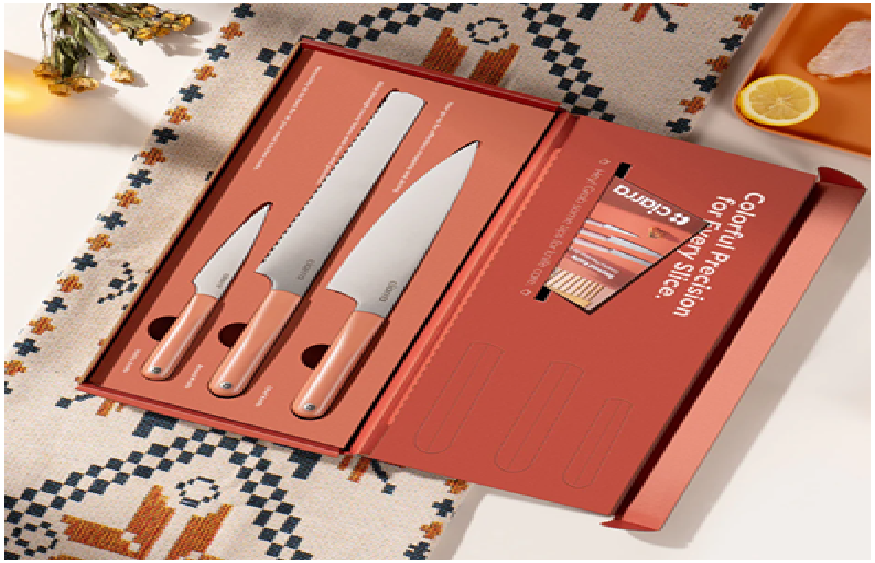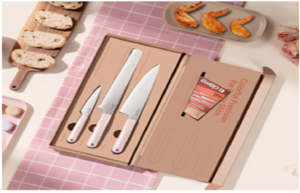A well-crafted knife set is an essential tool for any kitchen, whether at home, in professional catering, or for outdoor use. Knife sets typically include a variety of knives, each designed for specific tasks. Understanding the common types of knives found in a knife set, their roles, and the appropriate methods for cleaning and sterilizing them is crucial for maintaining their longevity and functionality. In this article, we will explore the common types of knives found in knife sets, their application across different environments, and proper cleaning and sterilization techniques.
Common Types of Knives in a Knife Set
Knife sets typically consist of several core knives that are versatile for a variety of tasks. Here are some of the most common types found in a standard knife set:
Chef’s Knife
The chef’s knife is the all-purpose knife in the set, featuring a broad blade that tapers to a sharp point. Typically 8-10 inches in length, this knife is ideal for chopping, slicing, dicing, and mincing vegetables, fruits, and meats. It is an essential tool in any kitchen.
Paring Knife
A small knife, usually around 3-4 inches, with a sharp, pointed blade, the paring knife is perfect for intricate tasks such as peeling, trimming, and shaping fruits and vegetables. It offers precision when handling small items or performing delicate tasks.
Bread Knife
This knife has a long, serrated blade designed for slicing through crusty bread without crushing the soft interior. The serrated edge makes it easy to cut through delicate foods like bread, tomatoes, and cakes.
Utility Knife
The utility knife is a mid-sized blade (about 4-6 inches) that fills the gap between a chef’s knife and a paring knife. It is useful for tasks such as slicing sandwiches, cutting small meats, or portioning vegetables.
Santoku Knife
A Japanese alternative to the Western chef’s knife, the Santoku knife typically features a shorter, wider blade with a flat edge. It excels in slicing, dicing, and mincing, especially in smaller, more precise tasks.
Boning Knife
A boning knife has a thin, flexible blade designed for removing bones from meat, poultry, and fish. Its sharp edge allows it to make clean cuts around bones and joints.
Carving Knife
A long, slender knife designed specifically for slicing cooked meats such as turkey, roast beef, or ham. It allows for thin, even slices, making it ideal for serving portions.
Steak Knives
These knives are typically part of a set of six or more and are designed for cutting cooked meat at the table. They usually have a serrated edge to make cutting easier without tearing the meat.
Applications of Knife Sets in Different Areas
While the core knives in a set remain similar, their applications can vary depending on where the set is being used. Let’s look at how knife sets are applied in different settings:
Home Kitchens
In a home kitchen, a standard knife set, typically consisting of a chef’s knife, paring knife, bread knife, and utility knife, is sufficient for most tasks. Home cooks will rely on the chef’s knife for general preparation and the paring knife for more precise tasks. Specialized knives like the boning knife or carving knife might be used occasionally for larger cuts of meat or special occasions.
Outdoor Use
Knife sets intended for outdoor use, such as camping or hunting, tend to focus more on utility and durability. A good outdoor knife set often includes a sturdy chef’s knife, a multi-purpose utility knife, and a smaller, folding knife for delicate tasks. Materials in these knives are typically more rugged, and their construction is designed to handle rougher use, including cutting through tougher materials like wood or bone.
Professional Catering
In a professional catering or restaurant setting, chefs rely on a wider variety of specialized knives. A chef’s knife, paring knife, and boning knife are essential, but professional kitchens may also feature additional knives like filleting knives, slicers, and cleavers for butchering, filleting fish, or slicing large cuts of meat. The key in a professional setting is efficiency, with each knife serving a specific function to help chefs work quickly and precisely under pressure.
Cleaning and Sterilizing a Knife Set Properly
Proper cleaning and sterilization of knives are crucial to maintaining their sharpness and preventing contamination. Follow these steps to clean and sanitize your knife set:
Initial Wiping
After each use, immediately wipe the blade with a clean, damp cloth to remove any food debris, oils, or juices. This step helps to prevent residue from drying and staining the knife.
Rinsing and Scrubbing
If necessary, rinse the knives with warm water and mild dish soap. Avoid using abrasive sponges or steel wool as they can scratch the surface of the blade. For stubborn food residue, use a soft brush or nylon scrub pad.
Deep Cleaning
Periodically, deep clean your knives by soaking them briefly in warm water with dish soap. Use a soft cloth or sponge to scrub the entire blade and handle, making sure to clean all parts of the knife, including the bolster (the thick junction between the blade and the handle).
Drying the Knives
After cleaning, always dry the knives thoroughly with a soft towel. Never leave knives wet, as prolonged moisture can lead to rusting, especially on carbon steel knives.
Sanitizing the Knives
After cleaning, sanitize your knives to eliminate any bacteria. You can use a food-safe sanitizer, or a solution of diluted bleach (1 tablespoon per gallon of water) or vinegar (1 part vinegar to 4 parts water). Let the knives sit in the solution for a few minutes, then wipe them dry with a clean towel.
Related: when must a knife be cleaned and sanitized
Differences Between Cleaning and Sterilizing Knife Sets Made of Different Materials
Different knife materials require specific care when it comes to cleaning and sterilizing. Let’s explore the common knife materials and their unique requirements:
Stainless Steel Knives
Stainless steel is the most common material for knives due to its resistance to corrosion and rust. When cleaning stainless steel knives, avoid harsh cleaners that can dull the blade. A gentle dish soap and warm water are usually sufficient for cleaning. To sterilize, use a mild sanitizing solution or alcohol, but never leave it on for too long, as it can dull the blade.
Carbon Steel Knives
Carbon steel knives are more prone to rust than stainless steel, so they require extra care. After cleaning, always dry these knives immediately and store them in a dry environment. To sterilize, use a mixture of vinegar and water (but never bleach, as it can react with the carbon steel and cause discoloration). Carbon steel knives should also be oiled regularly to prevent rusting.
Ceramic Knives
Ceramic knives require special attention as they are very hard but brittle. Avoid using ceramic knives on hard surfaces and always clean them gently with warm, soapy water. Do not use abrasive pads that could scratch the blade. Sterilizing ceramic knives is straightforward, as they are non-porous and resistant to bacteria. However, handle them with care to avoid breaking or chipping the blade.
Damascus Steel Knives
Damascus steel knives are often prized for their intricate patterns and sharpness. Like carbon steel, Damascus blades need to be dried immediately to avoid rust. To sanitize these knives, use a food-safe cleaner or diluted vinegar, but avoid harsh chemicals that can damage the aesthetic patterns. Damascus knives require careful maintenance to preserve their integrity.
Conclusion
A well-maintained knife set is an invaluable asset in any kitchen, whether at home, outdoors, or in professional catering environments. Understanding the types of knives in your set, how to use them correctly, and the best practices for cleaning and sterilizing them ensures their longevity and performance. Always adapt your cleaning and sanitizing methods to the specific materials your knives are made of to maintain their quality. By following the proper care guidelines, your knife set will remain a reliable and essential tool for years to come.




